We finally made it to Poland! Third try is the charm! We weren’t sure if it would actually happen given the impending lockdown in Germany and around Europe, but to our relief and delight, it all worked out. We arrived in Krakow late Friday evening, armed with several masks, hand sanitizer, and Zinc.
We woke early on Saturday, ready for a full day of touring. We spent the morning at Auschwitz and Birkenau concentration camps and the afternoon at Wieliczka Salt Mine. The morning drive was beautiful and peaceful. We passed through the countryside mixed with forests that were at their peak with fall colors, including numerous trees bursting with bright orange and red leaves, our favorites!
As we neared Auschwitz, our driver stopped at a memorial nearby. Sitting on the original railroad tracks sat two freight cars, which were used to transport thousands of individuals to the concentration camps. Each wagon carried anywhere from 80-100 individuals, some spending weeks inside depending on how far they were coming from. Just down the street from the memorial sits the ruins of the Canada warehouse where the possessions that were stolen from the prisoners were taken and stored. Here, we learned that the building was named so because Canada was thought to be a country of great riches.
We entered Auschwitz by walking through the main gate, where thousands upon thousands of individuals entered unaware of what lay ahead. The gate “welcomed” the visitors with the words “Arbeit Macht Frei” (Work Brings Freedom) and was surrounded by fences lined with barbed wire. Here, our guide explained that because Auschwitz was at the center of several rail junctions and, at the time, was in the middle of the countries occupied by the Nazis, it was an ideal location for the concentration camp.
We went inside a handful of the barracks during the tour, each one housing a different exhibit. The barracks were different than we were expecting. They were large brick buildings with separate rooms. They were already in place before this location became a concentration camp, where as the barracks at Birkenau were built for the concentration camp and were more of what we were expecting to see. One exhibit displayed pictures taken by the SS officers and two photographs that were taken illegally by one of the prisoners. Another exhibit displayed roughly two tons of hair belonging to almost 40,000 people, some still in braids and ponytails. The hair was saved, packed in sacks, and sold to companies as raw material to be made into fabric among other things. Another exhibit was dedicated to the prisoners' possessions and included hundreds of glasses, combs, and brushes. One display showcased the countless suitcases that were taken, many marked with the owner’s name, birthday, address, and deportation train. As we walked on, we entered a large room with a display of somewhere around 110,000 pairs of shoes ranging from work boots and walking shoes to sandals and bright red dress shoes. One of the last exhibits we visited in the barracks was dedicated to the children who were brought to the camp. Tragically, most of the children were killed immediately upon their arrival, leaving behind their clothes and tiny shoes, which were delicately displayed.
We walked by the Death Wall, pausing to pay our respects, and continued on, passing by the hospitals and facilities where many were subjected to inhumane medical experiments. We finished the tour by walking under the barbed wire and over to the crematorium, the heart of this nightmare. Looking up at the ceiling, we saw the holes where the cyanide pellets were dropped and passed by the ovens used to “hide the evidence” of this horror.
Following Auschwitz, we took a short drive to Birkenau, one of the subdivisions of the Auschwitz camp. As we approached Birkenau, our eyes were drawn to the simple entrance with an arch and rail lines running through. Staring at the entrance, it’s impossible not to think about where the rails lead... straight to the back of the camp, providing "easy" access to the crematoriums. Barbed wire fences and watchtowers surround the camp, and as we looked through the fence, we saw countless barracks or their remains lined in the grass. At the back of the camp, we saw the remains of two of the four gas chambers used to kill over one million individuals. Prior to the liberation, the SS destroyed the crematoriums, again, trying to eliminate evidence.
We walked through the women’s barracks and went inside one. A stale, damp, earthy smell is still present. Aimed to accommodate 400 prisoners, these barracks were often crowded with over 1,000 people expected to share the cement beds. We ended the tour walking out of the camp through a side gate. It feels wrong to think of these individuals as a number, but how do you wrap your mind around it? Each one of those people were loved by someone. They were a parent, a sibling, grandparent, friend, teacher, or neighbor. They each had their own family and were living their own lives before suddenly being stripped of it all. It’s heartbreaking and unimaginable and feels impossible to process...
Our visit to Auschwitz was tough, but it is a significant part of our history. At the end of our tour, our guide told us that many of the individuals who survived did so with the hopes of alerting others of what was happening at these camps, to try to stop the genocide, and to bring justice to all of the people who lost their lives. As we walked away from the camp and continue to reflect on this day, we try to keep that in mind. We try to honor the individuals who suffered and those who survived. We try to preserve their memory and pray this will never happen again. We recognize that what they went through is horrific and unacceptable, and in the end, we try to do our best to bring more love to the world, to shatter the hate and discrimination that is still present today in honor of them.
Following a heavy morning, we switched gears and headed to the Wieliczka Salt Mine.
The mine has been in use for over 700 years, and although we saw several chambers and walked down countless stairs (by the end of the tour, we were 130 meters underground), the area we explored was only about two percent of the entire mine.
We descended 800 steps to get to the first chamber and passed through several wooden corridors that lead us to the others. We saw numerous chambers, some were small enough that Jeff had to watch his head, where as others were massive. Some had sculptures that told a story, others had a small lake, but the coolest one of all was St. Kinga’s Chapel. This chapel is made entirely out of salt. Everything from the tile floor to the salt crystal chandelier was salt. The altar, the statue of Pope John Paul II, the artwork decorating the walls, including a nativity scene and the last supper, were all salt. It was incredible! One other fascinating fact we learned was that up until 2002, horses lived in the mines helping with the excavation. Because it was too difficult to lift them up and down, they spent their entire lives underground.
Thankfully, at the end of the tour, we did not have to climb back up all of the stairs, but instead took the miner's elevator up the shaft. It was a fascinating tour, and definitely something we’ve never seen before!
We finished the evening back in Krakow, walking around the city center and ordering way too many perogies from Pierogarnia Krakowiacy for dinner. Due to the current covid restrictions, all of the restaurants were closed and only available for take-out, so we ended up having a picnic in our Airbnb.
On Sunday morning, we set off for a free walking tour of the city. The other couple in our tour didn’t show up, which meant we had a private tour. We began our tour at the old city wall and St. Florian’s Gate. During the tour, we learned that Krakow was spared during WWII as Hitler had plans of making it a new Arian community. Because of this, many of the buildings are original. We wandered through the side streets and popped out at Rynek Główny, the main market square, near the old Cloth Hall and St. Mary’s Basilica (everywhere you looked there was a church). We continued on, making our way to the Wawel Royal Castle, where we saw “dragon bones” (aka mammoth bones), another church, and a fire breathing dragon.
Following the tour, we continued on our own adventure, heading over to the Jewish Quarter. With it being Sunday, a national holiday (All Saints Day), and 2020 covid, the town was very quiet. We had plans of visiting the Seweryn Udziela Ethnographic museum, as it was named after one of Jeff's ancestors, but unfortunately it was closed. We also had hopes of peeking our heads into a few churches, but many of those were closed as well. So instead, we simply strolled around. We stopped in Plac Nowy, ordering our first Zapiekanki, which is essentially a mushroom pizza with your choice of toppings baked on a loaf of French bread and topped with ketchup. It was interesting… given that neither Jeff nor I are big mushroom fans, we decided to stick with the other local favorite instead… You can’t go wrong with perogies!
We finished the evening off with another take out dish of perogies. This time we “splurged” and added an order of raspberry and white chocolate sweet perogies to the list. YUM!
We started Monday back in Rynek Główny. We stopped at one of the local street carts for an "Obwarzanek," aka a bagel (we had to since Krakow is the birthplace of the Bagel, first documented in 1496) and paused to listen to the famous trumpeter play his tune. The story goes that many years ago, in 1241, a heroic trumpeter was trying to warn the town of a Tatar invasion but was interrupted when an arrow was shot, hitting him in the throat and ending the melody mid-note. Today, the trumpeters continue to play the tune every hour, ending the song abruptly, just as it happened in the story.
Look close, can you find the trumpet?
Next, we crossed the square and made our way underground, beneath the Cloth Hall to the Rynek Underground Museum. Here we stepped back in time and walked through the ruins from the former market. We admired remnants of the old roads as well as displays of jewelry, tools, and even a few graves. Over time, Krakow’s main square has risen around four meters, which has made it possible for this museum to exist. Apparently, many restaurants around the square also have rooms underground where you can see old doors and windows that were once at ground level. Crazy!
We continued our stroll around the city, this time popping into a few shops as well as churches, eventually making our way back to the Jewish Quarter for an afternoon tour. We started the tour at the Old Synagogue, which was built in the 15th century. During the tour, we passed by several other synagogues, some blending in with the other buildings. Throughout the tour, we learned about the history of this neighborhood and eventually made our way across the bridge to where the former Krakow ghetto was located.
In the former ghetto, we learned about the “Empty Chairs” memorial and how each chair represents one thousand lives. The chairs point in different directions, for example, one points towards Schindler’s Factory, dedicated to the 1,200 Jews he saved, while others point to the concentration camp that was located over the hill, dedicated to the thousands of individuals who were taken there. We talked about Osker Schindler and learned about Tadeusz Pankiewicz, a pharmacist who insisted on staying in the ghetto to provide medicine for those trapped inside and shelter for others to avoid deportation.
Two heroes among many.
As we made our way back to Krakow's main center, we strolled over "Lovers Bridge," adorned with lover’s locks and acrobats flying through the cables. We stopped at Mr. Vincent’s for another set of delicious perogies (this time ordering apple cinnamon perogies for dessert) and continued to our Airbnb.
We ended the trip with an insanely early wakeup call on Tuesday morning with our alarms set for 2:45am …The only benefits of waking up that early were, one, Jeff was able to watch Monday Night Football, and two, we saw the sun rise over the clouds during our first flight. The early morning flight was not on our original itinerary, but sometimes you just have to go with the flow.
After landing in Düsseldorf, we experienced another first, joining in the “fun” of a covid test. Thankfully our test was a simple swab of the back of our throat and not up our nose! We received the results in less than 24 hours and were happy to learn that they were negative! Phew!



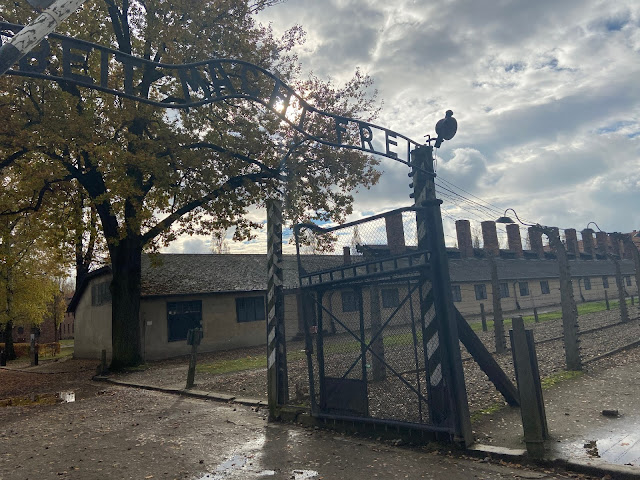













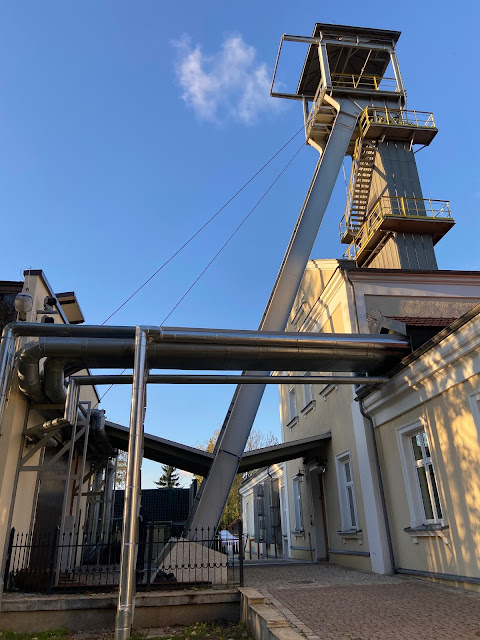








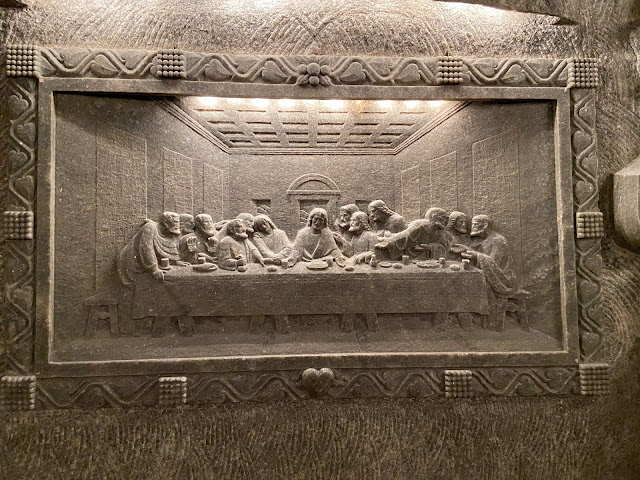












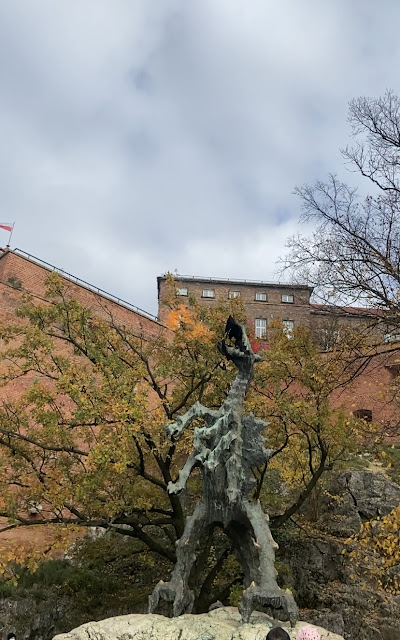
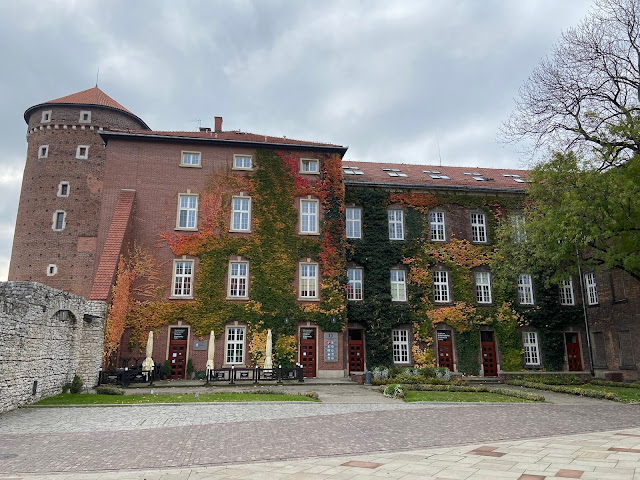




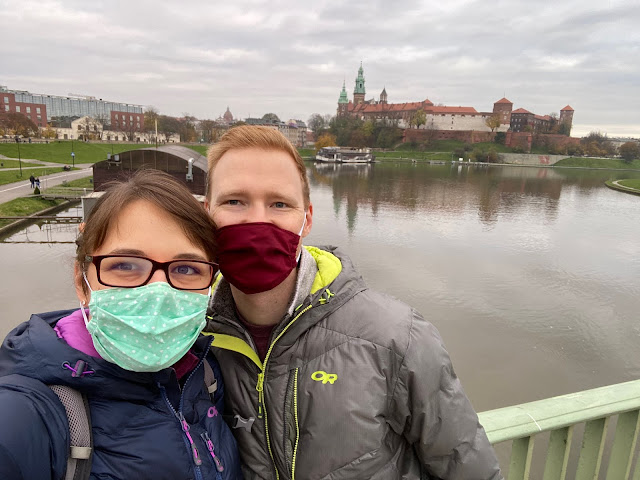














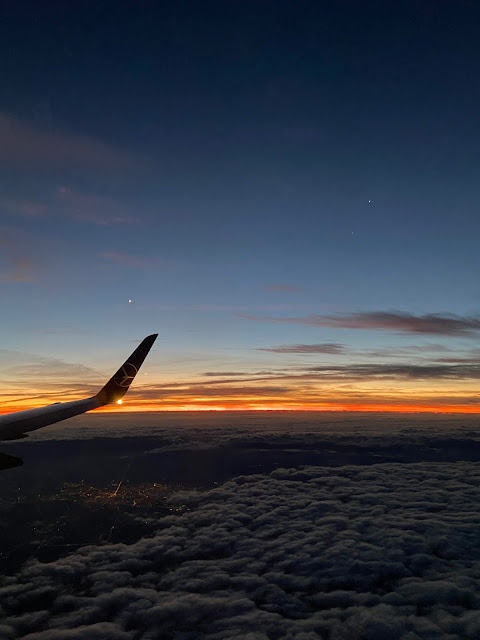

Looks like a fascinating trip with intense emotions and important history. Your photographs are amazing and so is your writing. I felt like I went along with you.
ReplyDeleteThank you! I'm glad you're enjoying the travels too!
Delete